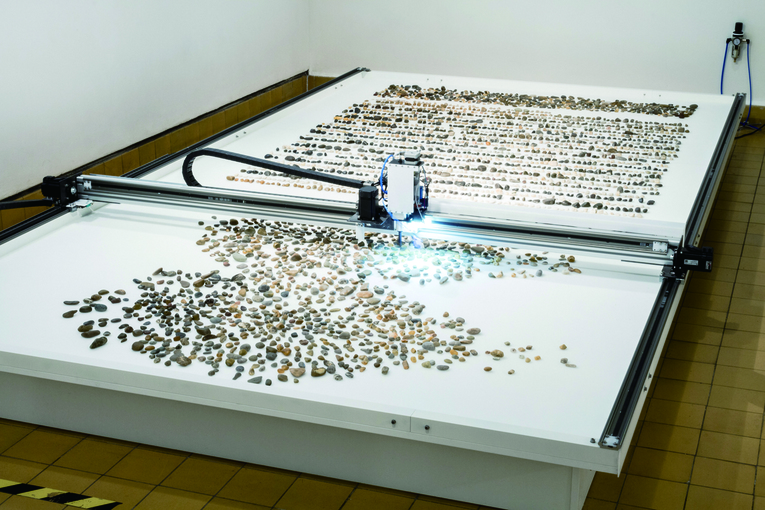20th Art Division Excellence Award
Jller
Media installation
Benjamin MAUS / Prokop BARTONÍČEK [Germany / Czech Republic]
Outline
Jller is part of an ongoing research project at the intersection of the fields of industrial automation and historical geology. It is an apparatus that sorts pebbles collected from the German river Jller according to their geologic age. The stones were taken from a spot close to the city of Ulm, right before where the Jller meets up with the Danube. After they are laid out on the approximately 2 x 4 meter platform of the machine, the structure of each pebble is automatically analyzed using an image recognition device, and by comparing them against predetermined standard features, their geological ages are estimated. Then, an industrial vacuum gripper does a preliminary sorting of the pebbles while simultaneously creating enough space on the platform, and finally, it lines up the pebbles in a grid according to age and type. As pebbles from rivers have distinct compositions and structures, their origins can be determined with some degree of precision. The stones from the Jller, although their geologic ages vary, consist largely of two groups with different origins: rocks that are the result of erosion in the Alps, and stones that were crushed and transported by the glaciers. The pebbles today carry the accumulated effects of their delicate interaction with the river throughout the years, and this work, while emitting inorganic mechanical sounds, invites us to reflect on their long history.
Reason for Award
Two artists—a German who studied robotics at the University of Tokyo, and a native of the Czech Republic, the birthplace of the word “robot”— collaborated in creating what they call “a very complex and useless machine” based on the notion that “the act of collecting and sorting things is part of what made ancient humans human.” A device resembling an XY plotter uses computer vision to identify some 7,000 stones, and rearranges them in a certain order with an industrial vacuum robot arm. The stones were collected from the banks of the Jller River, at a spot right before where the river flows into the Danube close to the city of Ulm, a university town that was once the capital of the Holy Roman Empire and also a place associated with historic figures like Napoleon and Einstein. Using a machine-learning algorithm for identification and analysis, the system renders the timescale of natural phenomena visible without any human intervention, just like the robots in the 1972 film Silent Running. This work is site-specific but with a universal theme, and unites geological history and artificial intelligence. Mutually contradictory elements are brilliantly combined here. An exceptional piece that particularly merits recognition at a media arts festival where so many of the other works only have a meta-perspective of time and space. (MORIYAMA Tomoe)



